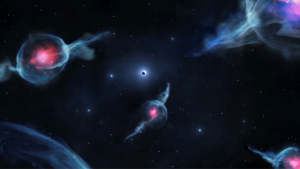In some galaxies there is little, and in some there is too much.Dark matter, the mysterious, invisible material that makes up much of the mass of galaxies, including our Milky Way, is once again confusing scientists as new observations of distant galaxies conflict with current understanding of their nature.

The study revealed a surprising discrepancy between observations of the concentration of dark matter in three massive galaxy clusters, including trillions of stars, and theoretical computer simulations of how dark matter should be distributed.
“Either the simulation is missing a component, or we made a fundamental misconception about the nature of dark matter,” Yale University astrophysicist Priyamwada Natarajan, co-author of the study published in Science, said Friday.
When light from distant sources such as distant galaxies passes through matter such as another galaxy or a cluster of them, the light bends and bends, a phenomenon called “gravitational lensing.” Dark matter is the invisible glue that holds the stars together within the galaxy. It also creates an invisible wireframe that allows galaxies to form clusters. But it has very peculiar properties.
It does not emit, absorb or reflect light and does not interact with known particles. Most of the matter in the Universe, about 96%, is considered dark matter, and ordinary matter – the visible matter that makes up stars, planets and people – only 4%. The presence of dark matter is known only by its gravitational attraction to visible matter in space. It differs from the equally mysterious and invisible dark energy, which is considered a property of the cosmos and is driving the accelerated expansion of the universe.
Dark energy is repulsive. Dark matter is attracted by gravity. The new study included observations from the Hubble Space Telescope and the very large telescope of the European Southern Observatory in Chile. “When light from distant sources, such as distant galaxies, passes through matter, such as another galaxy or their cluster, the light bends and bends – a phenomenon called ‘gravitational lensing,'” said astrophysicist and lead author Massimo Meneghetti of the Observatory. astrophysics and space sciences in Bologna and the National Institute of Astrophysics in Italy.
New observations have shown that the effects of gravitational lensing created by galaxies inside huge clusters of galaxies were much stronger than modern dark matter theory has suggested, suggesting an unexpectedly high concentration of dark matter in these galaxies. “It’s pretty amazing,” Meneghetti said. While the observations and simulations appear to be inconsistent, some researchers think the problem lies with our computer simulations, not our understanding of dark matter.
New telescopes coming soon, such as the Euclid Telescope and the Nancy Grace Rome Telescope, may help clarify this issue. They can be used to make large samples of observations that will help us understand where the error lies.











